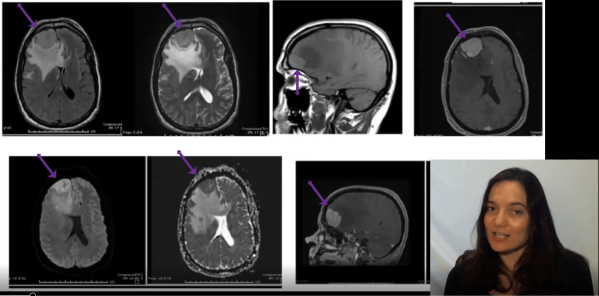Mystery case review #3 is one of a series of videos designed to review the variety of brain tumors that arise in the context of a familial tumor syndromes. Test your knowledge with questions posed to the audience in a quiz like format. In-depth answers are provided for each quiz question. This series is perfect... Continue Reading →
Video: Board Prep – Familial Tumor Syndrome, Mystery Case #1
Mystery case review #1 is the first of a series of videos designed to review the variety of brain tumors that arise in the context of a familial tumor syndromes. Test your knowledge with questions posed to the audience in a quiz like format. In-depth answers are provided for each quiz question. This series is... Continue Reading →
Video: Radiation and Brain Tumors Part 3 – Brain Tumors and Outer Space, featuring Dr Sandeep Burma
Part 3 of a three-part series reviewing the effects of radiation on the brain. Join in on this grand finale as we review brain tumor development in a pilot who had logged many hours flying aircraft at high altitudes. High altitude pilots at the edge of the Earth's protective atmospheric shield, and astronauts just beyond it,... Continue Reading →
Video: Radiation and Brain Tumors, Part 2 – Cured of One Cancer Only to Develop Another
Part 2 of a three-part series reviewing the effects of radiation on the brain. Radiation is commonly used to treat a wide variety of neoplastic conditions and often has great success, but sometimes the treatment can cause additional problems. Join me on a narrated tour of radiation’s dark side in this review of radiation-induced brain... Continue Reading →
Video: Radiation and Brain Tumors, Part 1 – Radiation Necrosis and Brain Metastasis
Part 1 of a three-part series reviewing the effects of radiation on the brain. Radiation is commonly used to treat a wide variety of neoplastic conditions and often has great success, but sometimes the treatment can cause additional problems. Join me on a narrated tour of radiation’s dark side in this review of radiation necrosis... Continue Reading →
Spinal Ependymoma: Gross Specimen
Ependymomas are tumors that arise from specialized glia called ependymal cells, which line the central cerebral spinal fluid (CSF) containing spaces within the brain and spinal cord called the ventricles and central canal, respectively. When ependymomas occur in the spinal cord, their central location requires that the surgeon cut through the spinal cord in order... Continue Reading →
Dorsal Root Ganglion
The dorsal root ganglia consist of the cell bodies of sensory afferent neurons and are located along either side of the spinal cord. These unipolar neurons characteristically have large cell bodies, which are needed to support the very long axons that carry sensory information from the distal extremities to the cord. Normal ganglia (such as the one... Continue Reading →
Tripolar Atypical Mitosis in Glioblastoma
Cell division occurs in four major stages (prophase, metaphase, anaphase, and telophase) during which DNA duplicates itself and condenses, chromosomes centrally align and are pulled apart by two centrosomes on either side of the cell, and the cytoplasm separates to form two separate daughter cells. Cancer cells are able to enter into cell division by bypassing the usual complex ballet of cell... Continue Reading →
Vestibular Schwannomas
Intracranial schwannomas most commonly arise from the vestibular portion of the Vestibulocochlear nerve (cranial nerve VIII). The central/proximal aspect of the nerve is myelinated by oligodendroglial cells whereas the distal/peripheral aspect is myelinated by Schwann cells. These distally located Schwann cells give rise to vestibular schwannomas that originate in the distal aspect of the nerve, usually within the internal auditory canal where it... Continue Reading →
Resorption of Embolic Material in Arteriovenous Malformation (AVM)
Vascular brain lesions have increased risk of intracranial bleeding and, therefore, present a challenge to neurosurgeons attempting surgical resection. Such tumors may first be embolized prior to surgical excision in order to reduce the risk of bleeding. Onyx, an ethylene vinyl alcohol copolymer, is one of many embolic agents available to accomplish this task. Onyx has... Continue Reading →










